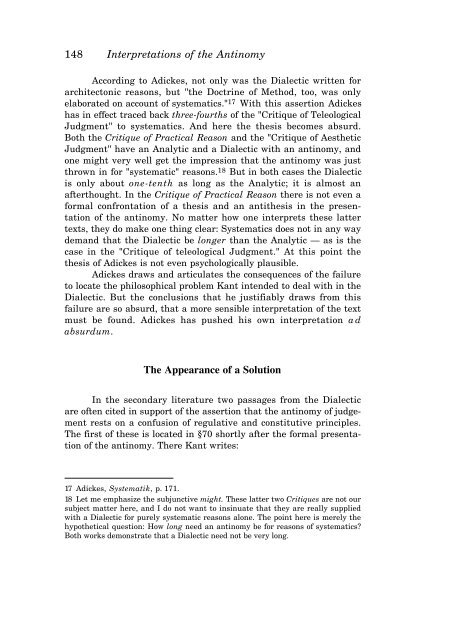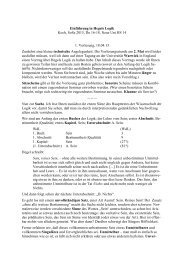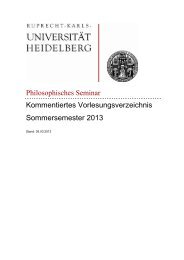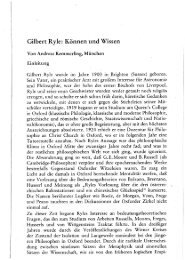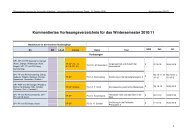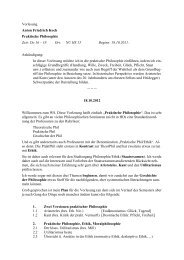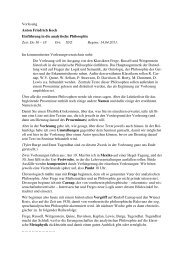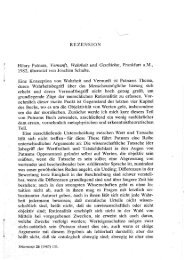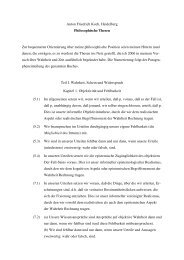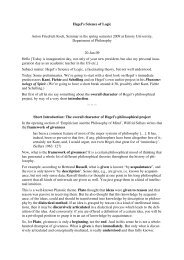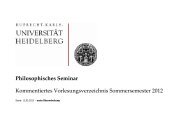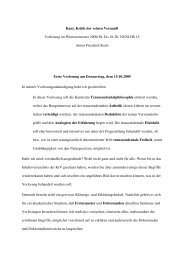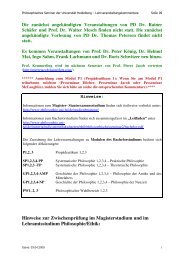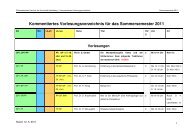KANT'S CRITIQUE OF TELEOLOGY IN BIOLOGICAL EXPLANATION
KANT'S CRITIQUE OF TELEOLOGY IN BIOLOGICAL EXPLANATION
KANT'S CRITIQUE OF TELEOLOGY IN BIOLOGICAL EXPLANATION
Create successful ePaper yourself
Turn your PDF publications into a flip-book with our unique Google optimized e-Paper software.
148 Interpretations of the Antinomy<br />
According to Adickes, not only was the Dialectic written for<br />
architectonic reasons, but "the Doctrine of Method, too, was only<br />
elaborated on account of systematics." 17 With this assertion Adickes<br />
has in effect traced back three-fourths of the "Critique of Teleological<br />
Judgment" to systematics. And here the thesis becomes absurd.<br />
Both the Critique of Practical Reason and the "Critique of Aesthetic<br />
Judgment" have an Analytic and a Dialectic with an antinomy, and<br />
one might very well get the impression that the antinomy was just<br />
thrown in for "systematic" reasons. 18 But in both cases the Dialectic<br />
is only about one-tenth as long as the Analytic; it is almost an<br />
afterthought. In the Critique of Practical Reason there is not even a<br />
formal confrontation of a thesis and an antithesis in the presentation<br />
of the antinomy. No matter how one interprets these latter<br />
texts, they do make one thing clear: Systematics does not in any way<br />
demand that the Dialectic be longer than the Analytic — as is the<br />
case in the "Critique of teleological Judgment." At this point the<br />
thesis of Adickes is not even psychologically plausible.<br />
Adickes draws and articulates the consequences of the failure<br />
to locate the philosophical problem Kant intended to deal with in the<br />
Dialectic. But the conclusions that he justifiably draws from this<br />
failure are so absurd, that a more sensible interpretation of the text<br />
must be found. Adickes has pushed his own interpretation a d<br />
absurdum.<br />
The Appearance of a Solution<br />
In the secondary literature two passages from the Dialectic<br />
are often cited in support of the assertion that the antinomy of judgement<br />
rests on a confusion of regulative and constitutive principles.<br />
The first of these is located in §70 shortly after the formal presentation<br />
of the antinomy. There Kant writes:<br />
17 Adickes, Systematik, p. 171.<br />
18 Let me emphasize the subjunctive might. These latter two Critiques are not our<br />
subject matter here, and I do not want to insinuate that they are really supplied<br />
with a Dialectic for purely systematic reasons alone. The point here is merely the<br />
hypothetical question: How long need an antinomy be for reasons of systematics?<br />
Both works demonstrate that a Dialectic need not be very long.


